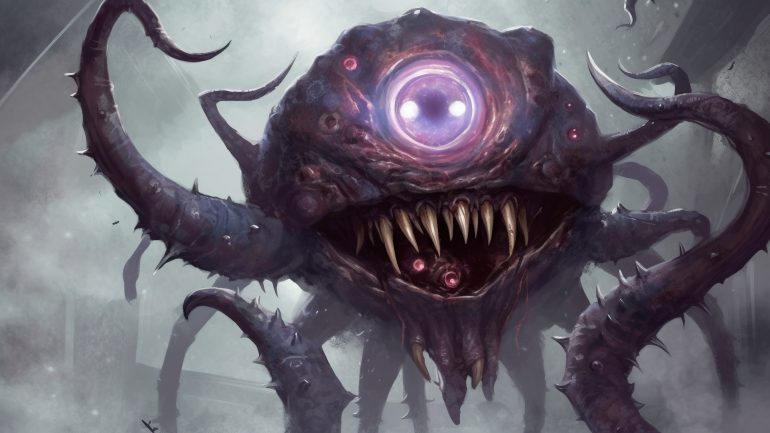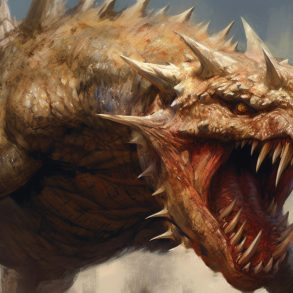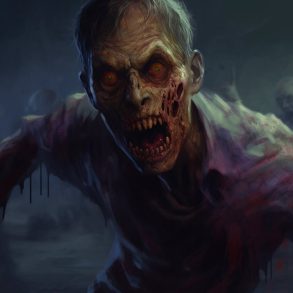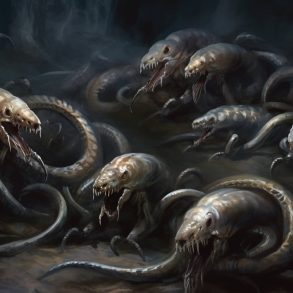Beholders are terrifying aberrations with a history of tormenting adventurers spanning almost fifty years back to the early days of the game. They’ve appeared in every edition since and have become an iconic creature in DnD, with one even adorning the cover of the 5E Monster Manual.
The Beholder 5E (MM, p. 26) has a spherical body with one large eye and tooth filled maw as its central features, with ten smaller eyes protruding atop stalks that crown it. It moves via flight and its body levitates at all times, even if unconscious, something that shapes the very homes it carves for itself.
All the better to see you with
All of those eyes aren’t just for decoration, each one has a power that can instill fear in even the hardiest of heroes. It’s written that the beholder uses the rays of its stalk eyes randomly, however, a DM can pick and choose to make the most of the effects.
Central Eye – This large eye emits a 150ft antimagic cone, rendering spells, magic items, and any other magical abilities entirely useless. Interestingly this includes the Beholders own eye rays, making positioning very important on both sides of the encounter
Charm Eye – This ray can charm a creature for up to an hour, turning enemies into allies. Unlike other charm abilities, a creature can be put under this effect repeatedly as saving doesn’t provide immunity at all.
Paralyzing Eye – The Paralyzed condition is very punishing, and that’s exactly what this ray inflicts. Even the Beholder’s bite becomes a terrifying weapon when it automatically crits you!
Fear Eye – Hide your Barbarians, this ray will frighten anyone that fails a Wisdom saving throw.
Slowing Eye – Similar to the Slow spell, this ray dumps a bevy of debuffs on you: halving your speed, making you unable to take reactions, and making you choose between an action or bonus action instead of both.
Enervation Eye – You might consider this one a draining experience, or at least you will if you fail and take 8d8 necrotic damage. Don’t worry, those of you lucky enough to save are still included with half damage. Now, isn’t that nice?
Telekinetic Eye – A Beholder may not have arms but it’s no lightweight, this ray allows it to move an object of up to 300lbs around. Or a creature that fails its save can be moved up to 30ft. in any direction, perhaps even right into the antimagic cone…
Sleep Eye – Yes, it’s possible a Beholder might give you the sleepy eyes, well, eye. Anyone that fails a save against this ray will fall asleep for a minute, unless they take damage, or another creature spends an action to wake it up.
Petrification Eye – Perfect for a little lair decoration, this ray has the potential to turn a creature to stone if they fail two saves. The first failure restrains you. Next turn, another failure turns you into a statue unless someone casts Greater Restoration or similar on you.
Disintegration Eye – You probably thought it couldn’t get worse, right? No need to worry, it does! You’ll need to succeed on a Dex save against this ray or take 10d8 force damage. Oh, and if that drops you to 0hp you die and turn to dust–this means no Revivify. The question is, will your life get a chance to flash before your very eyes?
Death Eye – Does what it says on the tin, err, on the sheet? If you fail a Dex save you’ll take a whopping 10d10 necrotic damage, dying instantly if you are reduced to 0hp by the damage.
Perfection in paranoia
Beholders are very intelligent beings, but they’re also incredibly arrogant and paranoid. They hold themselves as superior to all other creatures, whilst also assuming that all other creatures seek their downfall and covet their treasures. This is a belief shared by the majority of Beholders to the point where they isolate themselves in distant areas, even carving entire cave systems out with their disintegration eye. You might think this would lead to isolated pockets of Beholder communities, but their hate for all others is only out matched by their hate for each other. Talk about seeing red!
Every Beholder thinks themselves perfect in every way, however, Beholders can vary in appearance wildly and any deviation from their individual appearance is considered a stain on their racial purity. All of this adds up to inevitable conflict that usually ends either in death or becoming a very lifelike statue.
Some Beholders overcome their extreme paranoia (to a degree) enough to enslave and employ other creatures, using them as tools to their own ends. These Beholders as so different from the normal that they’ve earned the name Eye Tyrants.
Alien lairs and warping reality
The alien minds of Beholders are so powerful, they can actually warp reality when they sleep. This leads to the creation of other Beholders (we’ll tackle that later), but also causes changes in the world up to a mile away from their lair. These effects are minor and harmless but can forewarn the presence of a Beholder to the informed adventurer. Effects can include harmless slime forming on objects like statues, marks on cave walls changing subtly, trinkets appearing where they weren’t before, creatures feeling like they’re constantly being watched, and so on. Creepily, these effects don’t persist, ending 24 hours after they appear, potentially causing nearby inhabitants to challenge their own sanity.
The actual lairs of Beholders favour high ceilings with numerous vertical tunnels, architecture displaying their unusual mindset and constant flight based movement. These layouts favour the Beholder tactically, making any parties without flight struggle to keep up with their maneuverability.
Superior maneuverability isn’t the only home advantage a Beholder has, whilst in its lair a Beholder can call upon the latent magic in their homes to their enemies detriment. Grasping tentacles bursting from a wall, slime coating the floor, and even the Beholder’s own devastating eye rays blasting from the walls.
There’s more of them?!
That’s right, there’s more than one flavour of Beholder, although admittedly, they’re all just different flavours of unpleasantness and death.
Death Tyrants are Beholders that have transformed themselves by dreaming of themselves living on in death. They vary in appearance from a typical Beholder, their flesh fallen away leaving just a floating skull, their eyes replaced by floating lights. The iconic antimagic cone is replaced by a cone of negative energy, preventing creatures within it from healing and raising any that die within it into obedient zombies. This allows Death Tyrants to create armies of undead if they wish, using them as guards and tools, disposed of as necessary and replaced easily.
Spectators are lesser Beholders, summoned from another plane via a ritual that consumes four severed Beholder eye stalks. Much smaller than a true Beholder, they only have two eye stalks on each side of their body and a different set of rays to accompany those eyes. The Paralyzing and Fear rays are familiar from their larger brethren, their wounding ray is a weaker version of the enervation ray, but the confusion ray is unique to them.
The Spectators’ abilities aren’t restricted to rays either; being able to reflect spells back against anyone it chooses (if the attack fails or they succeed their save), and befitting their roles they can create 24 hours worth of food and water for themselves. What is that role? Spectators are usually summoned to guard a place or object, doing so obediently for 101 years according to the terms it’s summoner sets. If they complete their service then they are free to do as they wish, if what they are told to guard is stolen or destroyed before then however, they are banished to their home plane. Free Spectators will often take residence in the location they guarded, however, their years of isolation drive them into madness, from referring to itself in third person to inventing fictional enemies.
Death Kisses are formed when a Beholder dreams about losing blood, their behaviour mirroring their creation. They’re muted in colour compared to their creator, the traditional eye stalks replaced by ten tentacles, ending with toothy mouths, though in poor lighting the can be mistaken for true Beholders. These tentacles are how the Death Kiss feeds, draining the blood from its prey, compulsively draining even rats dry through constant fear of starvation. Their bodies act as eldritch engines, turning the stolen blood into electricity, which can harm those that injure it and hurt those it tries to drain.
Gauths are Beholder kin that force their way into the world when a ritual to summon a Spectator goes awry, perhaps even pretending to be a true Beholder to those it appears before. They are ravenous beings, preferring to sustain themselves through draining the magic from magical items. They’re smaller than those they imitate, with only six eye stalks and four tentacles, aiding their impersonation. It’s eye rays are largely similar to a true Beholder, though it has a fire ray and a ray capable of temporarily draining magical items of their power. Its central eye can stun creatures and, when killed, a Gauth explodes, releasing the magical energy that it fed upon in life.
Gazers are the weakest of the Beholder family, being a miniature version of the Beholder that dreamed it into life, its body is only 8 inches wide. They follow their creator like aggressive puppies, utterly devoted to them. In return, the Beholder treats them like spoiled pets finding them amusing. They have four eyestalks that provide them with a dazing, fear, frost (cold damage), and weak telekinetic ray. Gazers will use their rays to hunt and bully small creatures, though it will avoid fighting anything it can’t kill, preferring to mimic their voices from a distance in a high tone. Some Gazers will even bond with a spell caster, acting as a familiar as long as they are at least a 3rd level caster.
As you can see, the Beholder is a tremendous foe to make even the sturdiest clerics want to turn a blind eye. This monster is what nightmares are made of–truly horrifying beasts that’ll make anyone wish they’d never beheld such a thing.
What say you, adventurer? Are you up to the challenge? If you’re a DM, and wondering where you can give one of these lovely Beholders a home, check out these mapmakers! Let us know in the comments if you’ve ever encountered a Beholder, and the outcome of your grisly tale, or if you’re looking forward to fighting one!





